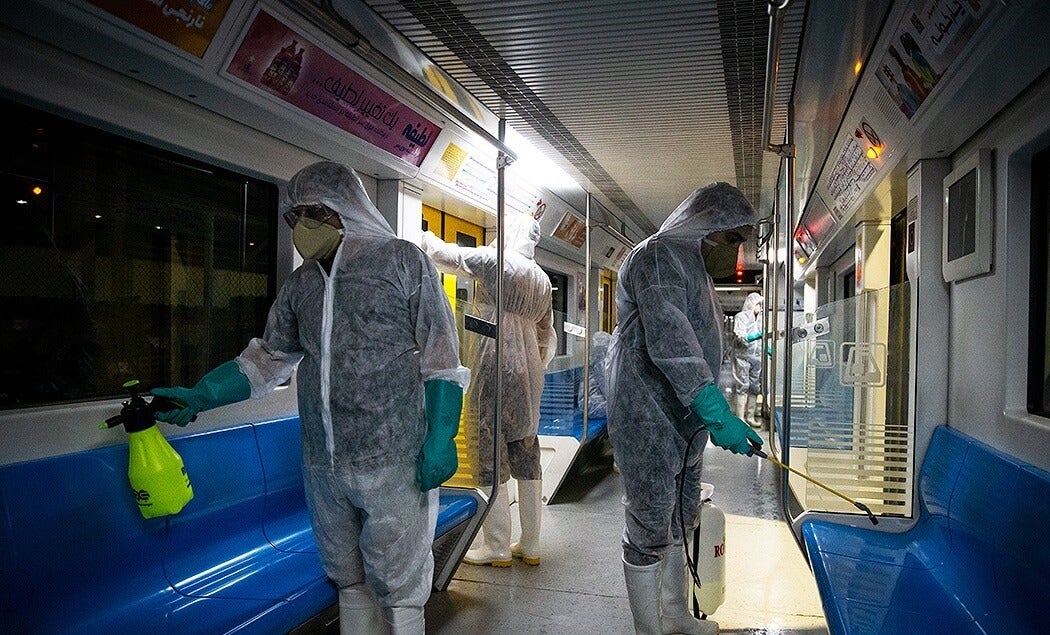Perhaps the most difficult and unfamiliar feature of the coronavirus pandemic is how the associated risk is rising rapidly through time. We are all used to managing our response to risks that are relatively stable, such as street crime or dangerous driving. The risk from the COVID-19 is different.
It is going to be with us for a while, and in many countries its rise looks exponential. This steep, geometric progression is completely new to most of us. However, those who have lived through hyperinflation in Zimbabwe or Venezuela know what rapid and out-of-control feels like. In several countries, rates of incidence and of mortality have been doubling every three days: imagine fighting an army that on day three has doubled in size and after a fortnight is thirty-two times bigger than on day one.
So how do we manage our own personal risks through this extraordinary period, and how should companies help make risk-based decisions on behalf of their employees?

COVID-19 risk is determined not only by the hazard but also by mitigative actions, the susceptibility of the infected person and the level of care available. As the hazard levels rise, the level of care is also likely to deteriorate – whether from health workers getting ill, or from a lack of intensive care beds. We have already seen this in Italy. As the quality of care has become stretched, the proportion of those seriously ill who have then sadly died has also risen. Timing in terms of when an infected person enters a healthcare setting becomes a major determinate. If you had a choice as to when to get infected, you would want it when healthcare resources are not stretched.
But let’s start with the hazard. Your own personal hazard will principally be determined by the potential for an infectious individual to be close enough, for long enough, to infect you with COVID-19. The infectious individual may no longer even be present – the virus could be left on a chair or handgrip on a bus or taxi.
Supposing you use a subway or underground train? What is the chance you are sharing a carriage with someone who is infectious?
We need to estimate the incidence in the population. The only figure reported each day is how many new cases and deaths have been identified in each country. Of course, once identified, all these individuals should have been isolated. We want to estimate the numbers of the “unidentified infectious.” This will include all those picked up on the following day, plus those yet to be identified. There is a wide range of estimates on this number. As a working assumption, to find the number of unidentified (and non-isolated) infectious we can double the number of those picked up on the following day.
This assumes that health workers are successfully identifying all new cases. One check is to compare the numbers of those identified as “infected” with the number of attributed deaths. The death rate in France has been 1.6 percent and in the more thorough testing environment of South Korea 0.7 percent. Compared with the death-to-infected ratios in Italy or Iran these ratios imply tens of thousands of missing cases, and/or higher rates of mortality among those infected, perhaps driven by older age (Italy?) and inadequate healthcare provision (Iran).
In Italy, 3,590 new COVID-19 cases were announced on March 15. If we double that to estimate the number of unidentified infectious individuals in the country, then given the 60 million population of Italy the probability that someone is infectious and undiagnosed is 120 per million. However around 60 percent of these cases are in the Lombardy region with a population of 10 million, where these “unidentified infectious” can be calculated to make up 432 per million people.
This compares with the 342 new cases in the U.K. on March 14, which doubled would give a probability someone is “unidentified infectious” of around 11 per million.
If you are on a train or subway car this week at rush hour, you can assume you are surrounded in a single carriage by a hundred people (the numbers are a little higher on the London Underground). In Italy, assuming a train was running, on average the chance of sharing your ride with an infectious person is therefore 1 in 80 and in Lombardy 1 in 23. Now ride that train to and from work five days a week, and your odds in Lombardy for sharing a carriage with at least one infectious individual have risen to about 1 in 3. For a week’s rush hour commuting in London the equivalent probability would currently be more like 1 in 90.
And in place of a railway carriage this could be a cable car at a ski resort in which you may be taking multiple journeys during the day or the week (although unlike commuting you won’t be doing this long-term).
Of course, you do not come into contact with everyone in the carriage. Maybe 10 percent of your fellow travelers are in your immediate space (which can be packed with up to six people per square meter). Therefore, you could dilute these hazard probabilities by a factor of ten. From contact tracing, we know the chance of picking up the virus from a brief contact on a train is quite low – call it 10 percent. These probabilities make the risk more manageable (1 in 9,000 in London of picking up a viral dose after a week’s commute). And we have not considered the impact of mitigative actions, like repeated hand washing, on reducing the potential that personal contact leads to infection.
How does this compare with the hazard of catching a plane? On a plane, you spend much longer with the people in your immediate vicinity. Studies have found an increase of influenza transmission from people sitting two rows in front and two behind. However, in the 2003 SARS outbreak 45 percent of the cases transmitted on a flight were from outside the two-row zone. Again, maybe 10 percent of the passengers could have the potential to infect you (if they were infectious).
More contact comes at airports, around check-in, security, lounges, boarding, immigration and baggage collection: six phases in each of which you may come into fairly brief contact with another ten or twenty people. Your contacts before and after the flight could even be more significant than those while airborne.
The chance of infection could be estimated by looking at the national or regional prevalence of infection at both ends of the flight. Flying out of London, today’s probability of having an infectious passenger on a full flight of 300 would be lower than 1 in 300. This will rise as the number of infections grows (currently doubling every three or four days), although as the number of empty seats rises, so the exposure could be reduced. For air crew, the hazard gets compounded on every flight.
Going on a cruise looks far riskier than taking a flight, where three thousand passengers and crew are confined in each other’s company for several days. With levels of infection on a cruise ship even as low as those in the U.K., the probability of having an infected person on the ship would be more than three percent. However, the hazard on the cruise liner has some compounding factors.
First, the voyage will typically last several days so even those who were not infectious on departure could later become infectious. Second, passengers are likely to have flown to the port of embarkation, meaning they have already increased their risk before departing. The hazard levels quickly reach greater than 10 percent for there being at least one infectious individual on the cruise.
Of course, the public gathering does not need to be on a train, plane or boat. Religious services, family parties, weddings and even funerals are vulnerable to virus spread (60 people were infected at one funeral in the Basque Country, Northern Spain).
So far, we have looked at the hazard. To capture the full risk, we also need to look at the vulnerability of those exposed. Two key factors define the mortality rates: age and pre-existing infirmity (morbidity). Statistics from China of those who were infected by COVID-19 show a death rate of 14.8 percent for those in their 80s, 8 percent for over 70s, 3.6 percent for over 60s and 1.3 percent for over 50s. The rate drops further for over 40s (0.4 percent) and to 0.2 percent for lower ages.
An infected 80-year old person is 75 times more likely to die than an infected 20-year old. These ratios are very similar to age-related vulnerabilities for floods and wildfires (read this blog). Infirmity does correlate with age, but most deaths are also where there were preexisting conditions, such as coronary or lung diseases, diabetes or cancer.
We can see why older people should be avoiding public transport (or cruises) and, according to age and infirmity, should be self-isolating.
The situation is complicated by the way in which our own personal decisions can affect who else is impacted. If you get the virus, your partner is also likely to get it, so you may need to coordinate your protection strategies. Infected children may have mild symptoms but can bring home the virus to elderly grandparents. Work colleagues that came back from a vacation location that then became a COVID-19 hotspot may have inadvertently brought the virus back into the office.
For people who live together, as in a nursing home, there will be a high degree of cross-infection. What makes sense for one age group may not make sense for another. Health workers should be protected; if their children are sent home from a closed school, they may not be able to work.
As my colleague Gordon Woo has argued, when all intensive care beds are full and triage is in operation – which could result in older, more vulnerable patients not getting the level of care they need, then governments need to apply a general lockdown quarantine: the Chinese (and now Italian) solution, without concern for the economic consequences. In the U.K., earlier statements from the Chief Medical Officer implied the government would prefer to minimize the economic consequences by “blazing” the epidemic, but that would lead to higher death-rates among the vulnerable and elderly.
If we could guarantee a vaccine would be available before next winter, then we would want to minimize the infection over the summer months. However, if there is no prospect of a vaccine then there will be arguments to maximize herd immunity before next winter.
So, for COVID-19, refracted by our age, health, responsibilities, family arrangements and general attitude, we are all making continual risk assessments around commuting, visiting, working, even shopping and dining, as the level of risk inexorably rises around us. And, this continual risk awareness is set to continue, and heighten, in the weeks and months ahead.
Keep informed about the latest developments as RMS experts are producing regular blogs about COVID-19, talking to the media and issuing regular update reports.







